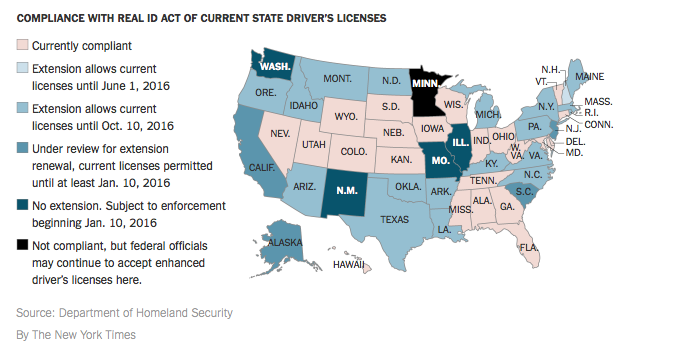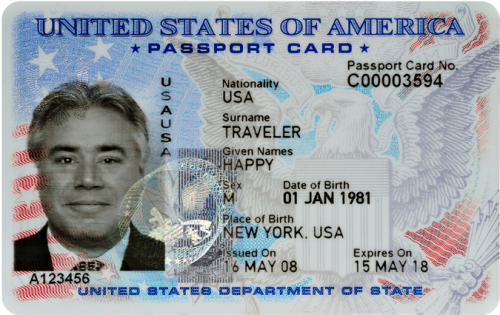 At Swift, after working in the travel industry for years, we’ve heard it all when it comes to ups and downs of traveling. Unfortunately, if you live in some U.S. States or Territories, air travel is about to reach a new level of annoying. Starting in 2016, you’ll need a passport to get on an airplane if you’re flying domestically with a state ID or driver’s license from these locations. Wondering why? You can thank the Real ID Act of 2005. While this change makes flying even harder, it’s been in place for over 10 years as a counterterrorism measure proposed by the 9/11 Commission. And hey, we all want to be safe, right?!
At Swift, after working in the travel industry for years, we’ve heard it all when it comes to ups and downs of traveling. Unfortunately, if you live in some U.S. States or Territories, air travel is about to reach a new level of annoying. Starting in 2016, you’ll need a passport to get on an airplane if you’re flying domestically with a state ID or driver’s license from these locations. Wondering why? You can thank the Real ID Act of 2005. While this change makes flying even harder, it’s been in place for over 10 years as a counterterrorism measure proposed by the 9/11 Commission. And hey, we all want to be safe, right?!
This legislation deems these State ID’s “Non-compliant” because people can get driver’s licenses and identification without proof of citizenship or residency. So, travelers from these areas now have two options. You can bring your passport with you when you fly or you can apply for an Enhanced Driver’s License. According to the Department of Homeland Security, states and other jurisdictions have made significant progress in enhancing the security of their licenses over the last number of years. As a result, approximately 70-80% of all U.S. drivers hold licenses from jurisdictions: (1) determined to meet the Act’s standards; or (2) that have received extensions. Individuals holding driver’s licenses or identification cards from these jurisdiction may continue to use them as before. (See image Below) Please be sure to check back with the US Department of Homeland Security for all updates on the status of your state, as this information is very fluid and subject to change. 
If you live in MN, IL, MO, NM, or WA, your state is not compliant with the Real ID act. Effective Jan 10, TSA Agents can legally start requiring a valid passport or enhanced driver’s license for domestic travel. Luckily, authorities have said they will give these states a 120 day grace period which means that technically, this law will not apply until summer of 2016.
Once the law is enforced, there will be a rush of people trying to get a passport. To avoid the rush, we suggest you apply for a passport now. If you are not in a hurry to get a passport, there is no need to apply through Swift. Here is information on the 4 ways you can apply for your passport.

TSA Approved Identification
Travelers age 18 and older can show one of the following forms of valid ID at airport check points to fly domestically:
- Enhanced Driver’s licenses or other state photo identity cards issued by Department of Motor Vehicles (or equivalent)
- U.S. passport
- U.S. passport card
- DHS trusted traveler cards (Global Entry, NEXUS, SENTRI, FAST)
- U.S. military ID (active duty or retired military and their dependents, and DoD civilians)
- Permanent resident card (aka Green Card)
- Border crossing card
- DHS-designated enhanced driver’s license
- Airline or airport-issued ID (if issued under a TSA-approved security plan)
- Federally recognized, tribal-issued photo ID
- HSPD-12 PIV card
- Foreign government-issued passport
- Canadian provincial driver’s license or Indian and Northern Affairs Canada card
- Transportation worker identification credential
- TSA does not require children under 18 to provide identification when traveling with a companion within the United States.
Don’t have a passport and not enough time to update your license before your trip? Not to worry, Swift can help you Expedite a New Passport in as little as 1 day!
Other helpful articles:
- Will Illinois License Be Accepted by TSA?
- Illinois Licenses, IDs No Longer Considered Federally Compliant
If you have any questions about this new policy, don’t hesitate to call the Swift Team at 877-917-9438!


2 thoughts on “Your Driver’s License Won’t Get You Through Airport Security Anymore”
This is our government in action making it difficult for its own people to fly in their own country, what’s next passport to cross state borders or federal US Drivers licenses. how is this helping secure our country from Terrorist when the world is already making fake passports to get into this Country?
Hi David… You bring up an interesting point. Looking back, this was passed 3 1/2 years after 9/11 on the heels of the Patriot Act.